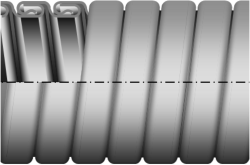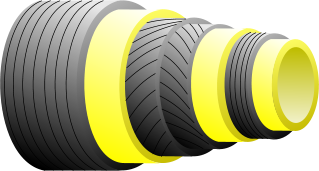HPHT Flexible Pipes
There are two principal types of high-pressure/high-temperature flexible pipes: bonded (Fig 1) and non-bonded (Fig 3).
Bonded HPHT Flexible Pipe
The bonded flexible pipe comprises synthetic elastomers and hosecord. The entire construction is bonded together during curing of the rubber.
The end terminations used on these constructions are bonded (epoxy resin filled) or swaged and when retro-fitted, prone to separation from the pipe body under high loading conditions.

Fig 1. Bonded Construction
The advantages of this type of construction are:
Light weight
Low cost
Excellent liner support
Good fatigue resistance
Good flexibility
Cover resistance to cut propagation
The disadvantages are:
Low temperature resistance (110°C) [short-term only]
Liner delamination
Birdcaging
Shallow water
High permeability
Poor chemical resistance
Poor abrasion resistance
Short lengths
End termination with temperature limitation

Fig 2. Interlock
If this product collapses or kinks it is thereafter permanently damaged and cannot be used. To avoid this eventuality, an interlocking stainless steel tube (Fig 2) is located in the bore.
Axial compression, excessive bending or twist will cause this pipe to birdcage rendering it unsuitable for any further use.
This design is limited to less than 10% of the world flexibles market due to its poor temperature and chemical resistance. It is for this reason that it is not produced in long lengths.
Non-Bonded Construction HPHT Flexible Pipe
The non-bonded flexible pipe comprises plastics and profiled reinforcement wire. The entire construction is loose (unbonded).
The end terminations used on these constructions are bonded (epoxy resin filled).
The advantages of this type of construction are:
Higher temperature resistance (<125°C) [short-term only]
Deeper water (<1000m)
Lower permeability
Good chemical resistance
Good abrasion resistance
Long lengths

Fig 3. Non-Bonded Construction
The disadvantages are:
Heavy weight
High cost
Birdcaging
Poor liner support
Liner loses chemical resistance with temperature
Poor fatigue resistance
Poor flexibility
Poor cover cut propagation resistance
End termination with temperature limitation
If this product is used to transport gas, rapid release of internal pressure could result in liner collapse, after which the pipe is permanently damaged and cannot be used. To avoid this eventuality, an interlocking stainless steel tube (Fig 2) is located in the bore.
Axial compression, excessive bending or twist will cause this pipe to birdcage and/or the liner support wire to open up rendering it unsuitable for any further use.
This product constitutes more than 90% of the world flexible pipe market due to its improved chemical and temperature resistance. It is for this reason that it is produced in long lengths for use as pipelines and risers.
CalQlata's HPHT Flexible Pipe
CalQlata has managed to overcome all the existing problems with bonded and non-bonded constructions by using the best materials available and applying them to the bonded construction.
The advantages of this design are:
Excellent temperature resistance (200°C) [long-term]
Lightest weight
Lowest cost
No liner delamination
Excellent liner support
Excellent fatigue resistance
Excellent flexibility
Excellent chemical resistance
Good abrasion resistance
Resistance to cut propagation
Extremely deep water (no limit in earth's oceans) with no cost implication
Lowest permeability
End termination with no temperature limitation
End termination that cannot be pulled off
The above highlighted advantages represent significant improvements over both existing designs.
The disadvantages of this design are:
None that have been discovered to date
This construction can be readily converted for low temperature (cryogenic) applications such as LPG transportation.
Deep Water
The problem with today's bonded and non-bonded pipes for use in deep water is that they must remain circular in order to function effectively, limiting them to shallow water or resulting in heavy and/or expensive constructions.
The patents filed by the largest manufacturer's of non-bonded HPHT flexible pipes for collapsible pipe do not work. Both companies have misunderstood the concept.
CalQlata's design can flatten (collapse) freely and reflate with no damage or fatigue effects and costs no more to manufacture than the standard construction.

